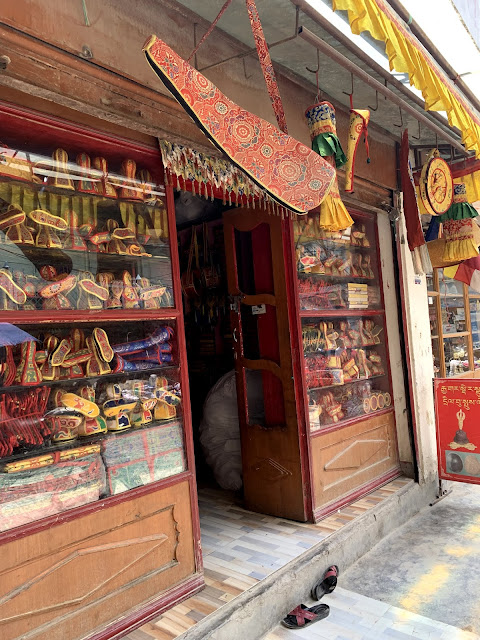Boudhanath Stupa and Tibetan Buddhism
I think I mentioned in the previous post that I am in the Tibetan Buddhist part of Kathmandu. Just a few minute walk from my apartment is the famous Boudhanath Stupa - one of the largest Buddhist stupas in the world.
To reach there, I have to navigate some narrow, muddy and pothole filled paths. Motorcyclists and pedestrians battle for access to the few dry inches remaining on the edges of the path, with the motorcyclists always winning. You quickly learn to keep your appendages and parcels close to your body.
As you get closer to the stupa building, you see it's distinctive Buddha eyes contemplating the four directions far above the hubbub of the area. There are many Buddhist shops selling brass ornaments and items of worship, red and gold meditation cushions, tailors specializing in dark red clothing for monks. As well as shops creating prayer multi-colored prayer flags.
Each shop is burning incense. Large incense censors pour exotic and penetrating fragrance into the street. The Tibetan incense is disarmingly potent. The various scents evoke strong emotions in me as I walk by.
To reach there, I have to navigate some narrow, muddy and pothole filled paths. Motorcyclists and pedestrians battle for access to the few dry inches remaining on the edges of the path, with the motorcyclists always winning. You quickly learn to keep your appendages and parcels close to your body.
As you get closer to the stupa building, you see it's distinctive Buddha eyes contemplating the four directions far above the hubbub of the area. There are many Buddhist shops selling brass ornaments and items of worship, red and gold meditation cushions, tailors specializing in dark red clothing for monks. As well as shops creating prayer multi-colored prayer flags.
Each shop is burning incense. Large incense censors pour exotic and penetrating fragrance into the street. The Tibetan incense is disarmingly potent. The various scents evoke strong emotions in me as I walk by.
When you finally reach the stupa, it is a fantastic display of religious and secular activity. Around the stupa itself pilgrims and monks are performing Kora or meditative contemplation as they circumambulate the stupa. It takes about 10 minutes to make one revolution. Typically a pilgrim will make 1, 3, 11 or any other odd number of revolutions. Some monks or pilgrims will walk a full day or more on religious holidays.
Follow me on one revolution around the stupa.
Yesterday I performed 13 revolutions and I allowed myself to sink into the experience. Focussing on the holiness of the place and tapping into the rich history of meditation and contemplation that have been performed around this monolith for centuries, I entered a serene contemplative state.
Truth be told, it is test of concentration to remain focussed on your meditative walk. If your eyes stray even briefly to the left, distractions abound. Tibetan shops of every kind ring the path. Coffee shops, restaurants, religious artwork shops, singing bowl shops and more are bustling with tourists.
Various causes set up tables soliciting donations around the stupa walk. People requesting money for sick relatives etc. One cause that touched my heart was an organization raising money for care of the homeless street dogs. Some young women were bathing and caring for the stray dogs. I felt to donate in honor of Lucky- my dog back home.
Yesterday my mission was to find a Thangka art school that would accept me as a student. I had several special requirements that I needed to be fulfilled in terms of a teacher and learning program. After some searching I found a great teacher who will allow me flexibility with my schedule. My next blog will be about Thangka Art. I think you will find it intriguing.
I will end with a photo of my lunch yesterday- a Nepali Thali lunch set as it is called. It includes rice, spicy vegetable, dal or lentil soup, vegetable salad, sweet yogurt, fried papadam wafer, spicy pickle and wonderful sauteed greens!





Comments
Post a Comment